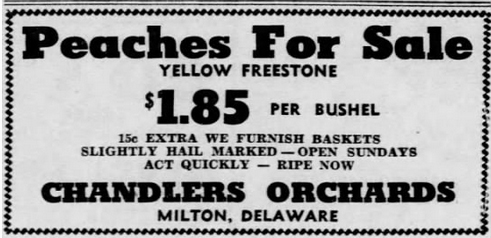
Within the memory of people living today, an orchard inside the Milton town limits, planted with hundreds of peach and apple trees, burst into bloom in the spring and bore many tons of fruit from July to October. This was the Chandler Orchard, owned by William H. Chandler and his family since the 19th century. In the Milton Letter of April 27, 1906, David A. Conner wrote this short paragraph:
William Chandler’s pear orchard is now in a beautiful condition. 800 trees are in full bloom shedding their aroma over nature, and gladdening the hearts and charming the eyes of the beholders.
Forty-one years later, William W. Crouch’s Milton News letter of April 25, 1947, makes a similar observation:
The commercial peach orchards around Milton were in full flower last weekend. The prospect for a banner crop of peaches is excellent at this time. The Chandler orchards are a riot of color, as is also orchards west of town and at Nassau. Many sightseers were at these orchards on Sunday, and many cars were parked along the roadside while occupants feasted on the riot of color displayed by the trees.
These were by no means the only mentions of the Chandler Orchard in the press. David A. Conner’s lyrical description contrasts with the more journalistic statement of Walter C. Crouch, but both make the reader hunger for an image of hundreds of fruit trees in bloom. The fact that most of this magnificent orchard was situated within the Milton town boundaries is also striking, and a little sad; today, nothing remotely like the Chandler Orchard can be found within Milton or for many miles in any direction.
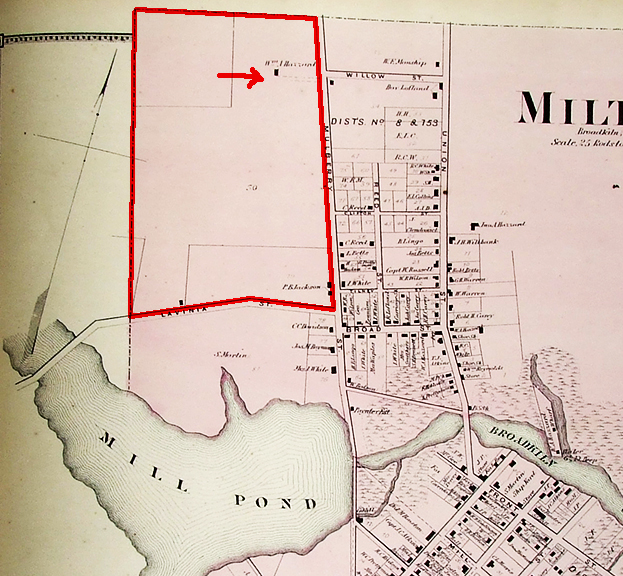
The orchard was located at the western end of town, bordered on the east by Mulberry Street, on the north by Route 16, on the west by the Milton town boundary, and on the south by Lavinia Street—more than 500 acres. It included all of the land that is today occupied by the Clipper Square Shopping Center, the Milton Post Office, Shipbuilders Village, and the H. O. Brittingham Elementary School.
The property had been farmed for generations before it came into the Chandler family. The Beers Atlas map of Milton, published in 1868, shows a house located across from the entrance to Willow Street labeled “Wm. A. Hazzard.” This was William Asbury Hazzard (1813 – 1895), son of David A. Hazzard, the 29th governor of Delaware. William’s daughter was Mary Elizabeth Hazzard (1843 – 1921), who married Lewis B. Chandler (1841 – 1908) in 1865. In the thirty years between her marriage to Lewis Chandler and the death of her father, numerous property transfers from the Hazzards were made to Mary Elizabeth Chandler. While the exact document that transferred the orchard property to her has not yet been located, it is safe to say the property was at some point transferred to Mary Elizabeth and Lewis B. Chandler, and from them to their son William H. Chandler (1866 – 1949). References to Tom Spencer (orchard manager) living in a house on the orchard grounds around 1894, and a mention of William H. Chandler having a large orchard of pear, peach and apple trees, would indicate that Chandler had the use of the land prior to that year, either by ownership or through the permission of his parents.
In a December 25, 1991 article in the Wilmington News Journal, local historian Mary King Morgan described William H. Chandler, Sr., as “an alert, quick man with much executive ability.” He maintained homes in both Scranton, PA and in Milton, and traveled between the two locations to review and supervise packing and shipping operations.
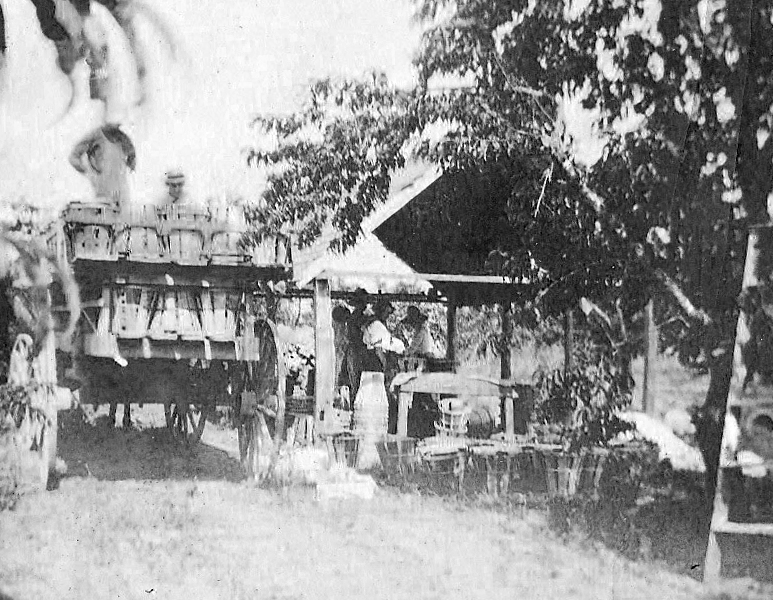
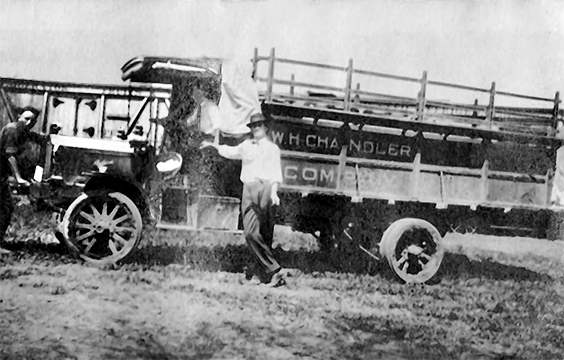
The Milton News letter correspondents–David A. Conner and his successor Walter W. Crouch—would mention Chandler’s orchard at least three times every year: once when the trees budded, and the anxiety over a possible late freeze would manifest itself; once when the trees bloomed, and with them the urge to rhapsodize was impossible to resist; and several times more when the ripe fruit was picked, usually in great quantity, and shipped by steamer, rail and truck to northern markets.
From the Milton News letter of February 17, 1893, we know that William H. Chandler bought a one-half interest in William Parker’s mercantile business at that time, and ran other businesses as well. The first mention of production out of the orchard itself appeared in the August 21, 1896 Milton News letter, stating that William H. Chandler shipped four carloads of peaches produced in the old Hazzard farm—the Chandler Orchard.
The Milton News letter of October 9, 1896 reported that William H. Chandler left the Parker and Chandler mercantile partnership in Milton at the beginning of the peach season and moved to Scranton, PA, to begin a wholesale fruit business. That business proved quite successful, but he still operated his orchard in Milton. He proved to be an astute fruit grower, even as an absentee owner. He employed a succession of capable managers, beginning with Thomas Spencer, to run the orchard. He often traveled to Milton to inspect his holdings, supervise packing and shipping, or plant new trees.
The Chandler Orchard in Milton had a celebrity visitor in 1944 – the Duke of Windsor, who abdicated the British throne so he could marry American divorcee Wallis Simpson. For more information and a newspaper clipping, please visit my previous post.

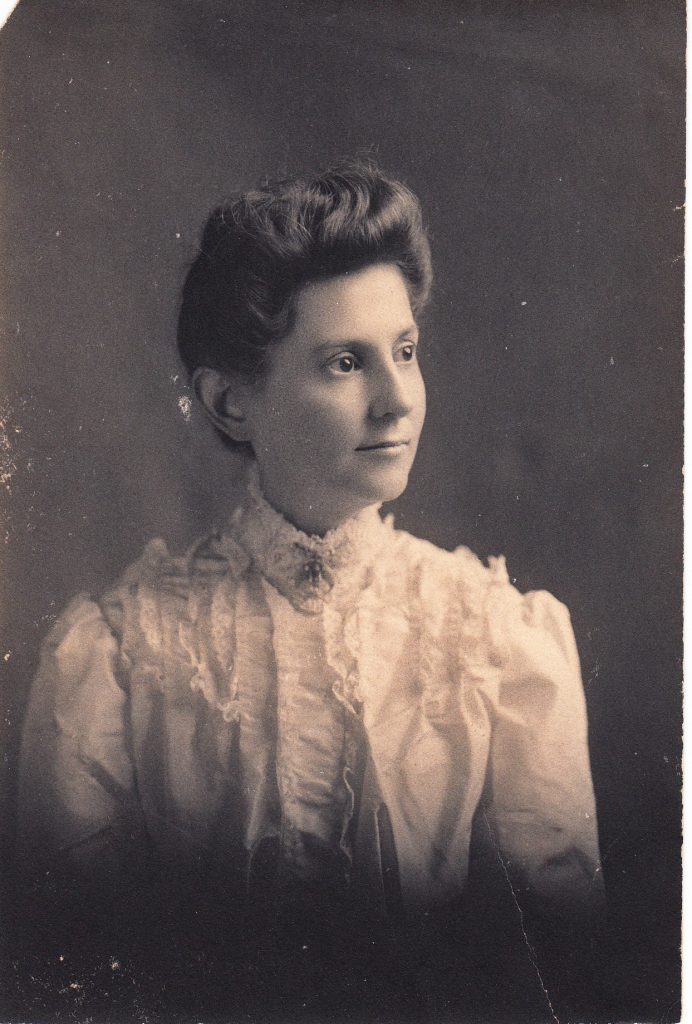
Chandler married Sarah Russell, daughter of Milton sea captain William B. Russell, in 1888. They had a son, William Hazzard Chandler, Jr., (1890 – 1929) and a daughter, Sarah Priscilla Chandler (1894 – 1993). When William Jr. died at the relatively young age of 49, daughter Sarah was left as the sole heir, and acquired the property upon her father’s death in 1949. Married to W. Leon Hamilton, she put one of their sons, Russell, to work managing the orchard. However, this did not go well, and by 1952 the trees showed the results of disease and lack of attention. The land was also contaminated with toxic compounds which were used in insecticide sprays for decades.[i]

The property was put up for sale by Sarah Hamilton, and Harrison Howeth Sr. bought it sometime in 1952 for $52,000, in the name of the Ellendale Corporation, a family business. The year of the sale is fairly certain; an ad appeared in the September 6, 1952 edition of the Gettysburg Times, placed by the Ellendale Corporation, offering used orchard equipment for sale. There was an element of “coming full circle” when the land changed hands; Harrison Howeth Sr. was a descendant of the Hazzard family on his mother’s side.
Epilogue
The Ellendale Corporation intended to raise peas, sweet corn, and lima beans for wholesaling to vegetable canneries. All of the fruit trees, now dead or decaying, were bulldozed into piles, roots and all, and burned to clear the land for planting. The bulldozer operator was William Lawson, from Harbeson, a WWII Army Corps of Engineers veteran. After five years of mixed results from vegetable farming, during which parcels of the farm property were sold off for operational funds, most of the remaining land was rented or sold to local farmers by the Ellendale Corporation, with the intent of returning to farming once conditions were deemed more favorable. This did not happen, however.
Part of the land was purchased in 1965 by the State of Delaware to build the H. O. Brittingham School. The rest of the property was sold off as part of the liquidation of the Ellendale Corporation in the 1970’s to settle the estate of Harry Howeth Sr. The area that is now the site of Shipbuilders’ Village underwent several changes of ownership until it was finally developed into low cost housing by the Krapfcandoit Corp in 1991. His son Harry Jr. and his two daughters came into possession of about 12 acres as a result of the settlement, which were sold over a period of years to Dr. Charles Wagner of Milton.
———————————————–
[i] This story and the remaining paragraphs were provided by Harrison Howeth, Jr. of Lewes.
